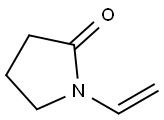Chemical Properties
Colorless liquid. Combustible.
Uses
A pyrrolidine used for biochemical research
Application
N-Vinyl-2-pyrrolidone (NVP) is an important precursor and
intermediate for process auxiliaries and additives. The main areas of use are the production
of polyvinylpyrrolidone and copolymers, the
preferred comonomers being vinyl acetate and
methyl acrylate. Ca. 10–15% of the monomer is
used in the pharmaceutical industry for the production of a polyvinylpyrrolidone–iodine complex used as a disinfectant. NVP is also used as a
reactive solvent for UV-curable resins for the
production of printing inks and paints as paper
and textile auxiliaries, and as an additive in the
cosmetics industry.
Definition
ChEBI: N-Vinyl-2-pyrrolidone is a member of pyrrolidin-2-ones.
Production Methods
Industrially, N-Vinyl-2-pyrrolidone (NVP) is produced by reacting 2-pyrrolidone with acetylene in highpressure autoclaves at 130–170 ℃ and pressures of up to 2.6 MPa. Vinylation proceeds in the liquid phase and is catalyzed by 2-pyrrolidone–potassium. The salt is obtained by adding 1–5% potassium hydroxide or caustic potash solution to fresh pyrrolidone and removing excess water by vacuum distillation (batchwise or continuously). The vinylation reaction takes place in a liquid-phase tube or loop reactor, or in a gas-phase reactor. To avoid the danger of acetylene explosions, nitrogen or propane mixtures of acetylene are used instead of pure acetylene. After the vinylation, the crude product obtained is purified by multistep vacuum distillation. Unreacted 2-pyrrolidone and derivatives can be recycled. Excess acetylene is removed by distillation and can also be recycled to the process.
?Another industrially important synthetic route is based on N-(1-hydroxyethyl)-2-pyrrolidone (HEP). In this process, HEP is dehydrated in the gas phase in a heterogeneously catalyzed reaction at 320–400 ℃ and 10 kPa. The obtained crude NVP is purified by vacuum distillation or crystallization.
General Description
1-Vinyl-2-pyrrolidinone is a colorless to yellow liquid, with a characteristic odor. Its melting point is around 13.5oC and boils at about 90-92oC. VP is completely miscible in water and in most organic solvents but partially miscible in aliphatic hydrocarbons. Industrial production of VP by reacting 2-pyrrolidone with acetylene at high pressure and temperature has been reported. The vinylation process proceeds in liquid phase and is catalyzed by 3-pyrrolidone -potassium hydroxide.
Chemical Reactivity
N-Vinyl-2-pyrrolidone (NVP) is stable toward alkalis at room temperature. Above 0 ℃ it is cleaved by aqueous mineral acids into acetaldehyde and 2-pyrrolidone; the latter reacts with an excess of NVP to give 1,1'-ethylidene-bis-2- pyrrolidone. Protic compounds such as amides, thiols, alcohols, and phenols add to the double bond according to the Markovnikov rule, for example, N-(1-phenoxyethyl)-2-pyrrolidone is formed with phenol. Catalytic hydrogenation produces N-ethyl-2-pyrrolidone. Hydroformylation on rhodium catalysts forms 2-N-(2-pyrrolidonyl)-propanal as the major product. On prolonged standing, particularly in warm conditions, NVP tends to polymerize. Industrially, N-Vinyl-2-pyrrolidone (NVP) is converted into polyvinylpyrrolidone using radical initiators.
storage
N-Vinyl-2-pyrrolidone (NVP) must be protected from heat and direct sunlight. Even in closed containers NVP can only be stored for a limited period because it tends to polymerize. Stabilizers are therefore added. N,N'-Bis(1-methylpropyl)-1,4-benzenediamine [101-96-2] is an important, NVP-soluble stabilizer that does not interfere with further processing. Use of this stabilizer allows the product to be stored for ca. 300 d at 20 ℃, and ca. 150 d at 25 ℃. Stabilization with solid sodium hydroxide that can be easily filtered off is not as efficient. Storage at temperatures close to the melting point results in separation of NVP from the stabilizer due to repeated solidification and melting. This shortens the shelf life considerably and can lead to uncontrolled polymerization. Solidified NVP must therefore be molten carefully in a water bath (max. 40 ℃) or at room temperature (max. 30 ℃) and homogenized by continuous agitation.
Toxics Screening Level
The initial risk screening level (IRSL) for N-vinylpyrrolidinone-2 is 0.04 μg/m3 based on
an annual averaging time.
